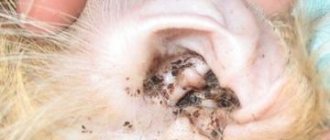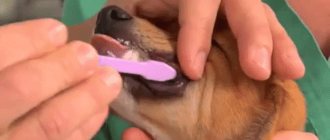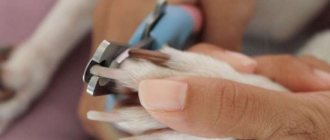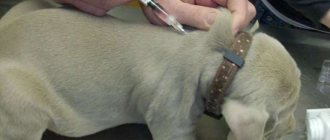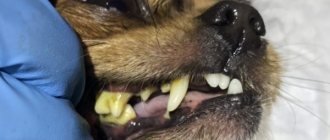Responsibility for the hygiene procedures of pets lies entirely on the shoulders of the owners. But not everyone knows how to carry them out properly and with what regularity. This article will tell you how to properly clean your dog's ears at home.
Read an important article on the topic: “What to do if your dog has ear pain: symptoms and treatment of otitis media.”
How to tell when it's time to clean your dog's ears
Due to the small stature of dogs, their ears become dirty with dust, splashes from puddles, grass, and insects. It is extremely important to keep these organs clean, but hygiene cannot be done every day.
Sebum and wax are essential to protect the delicate epidermis inside the ears. They protect the organ from sudden temperature fluctuations, mosquito bites and bugs. By removing the beneficial layer, you can harm your pet and cause microtraumas, inflammatory processes, fungi and bacterial diseases.
Moderation is important in everything. In lop-eared dogs, dirt accumulates faster in the ears due to the lack of adequate air circulation. To determine whether it is time to remove wax, you need to lift the skin and look into the sink. For breeds with erect ears, it is sufficient to carry out an examination once every 2 weeks.
A simple test will help you accurately determine the need for a hygiene procedure. A moistened cotton swab or swab should be rubbed along the inside of the dog's hearing aid. If the instrument is clean, you can postpone the event. If a small yellow or dirty coating forms, you must wait a few days. Identification of large lumps of sulfur requires their immediate removal.
How to clean your ears at home
Clean your ears once every 3-4 weeks. But each breed has its own nuances. For short-eared people whose ears are open, the procedure is carried out once every 5-7 days. The owner should inspect the animal's ears regularly.
Special products have been developed to remove wax from the ears of dogs.
Inspection
When examining the auricle, you need to pay attention to whether there is redness, discharge, or an unpleasant odor. If you notice any of the symptoms, you should take your pet to the veterinarian. You need to clean your animal's ears carefully so as not to damage the internal ones.
In dogs, the auditory canal is different from the human one; it is not straight, but curved.
Preparing for cleaning
Before cleaning, you need to prepare your pet's ears. You should moisten the shells with chilled green tea. Tea has an antibacterial effect. Do not pour the product into the ear canal.
Cleansing
For cleaning you will need cotton pads and swabs, wet wipes. Purification is carried out only in the external. The dog must be restrained by living on its side. If the organ hangs down, bend it.
Remove dissolved dirt with a damp cloth or moistened cotton pad. Remove excess wax with a rolled cotton swab, carefully moving down the ear canal. Then gently pull the stick up, wiping the ear canal.
Separate cotton pads and wet wipes should be used for each ear.
This will prevent infection from spreading from one sink to another.
Importance of the procedure
Cleaning a dog’s ear is a disease prevention and a way to promptly detect disorders that require a veterinary examination and proper treatment. The appearance of an unpleasant odor is a signal of problems. It could be a mite, yeast-like fungi, or bacteria.
Expert opinion
Anna Abramenko
An avid dog lover. Experience in veterinary medicine since 2009.
Ask a Question
Cleaning your ears on time is important. The question concerns not only the aesthetic side, but also health. When a large amount of sulfur secretions accumulates, a dog may develop otitis media. Parasites are often associated with inflammation.
Sometimes insects crawl into your dog's ears.
This happens especially often in the summer months. The greatest danger to the animal are ticks, which are carriers of dangerous infections. If you notice a tick attached to the ear, you should take your dog to the doctor.
Do not attempt to remove the insect yourself! Improper removal of the tick will result in the insect's proboscis remaining in the dog's skin, which will cause inflammation. If a foreign body (straws, blades of grass, seeds, etc.) is stuck in the animal’s ear canal, then you need to take the animal to a veterinary clinic.
Ways to clean your ears
There are different techniques. The scheme is almost always the same, the only difference is in the means used.
Professional drugs
The pet store offers a wide range of lotions and gels for gentle care of dogs' ears. Each product comes with instructions, but the procedure is roughly the same.
Cleaning principle:
- pull back the ear;
- pour 2-3 drops of product into the sink;
- hold the dog so that it does not shake its head;
- perform a light massage for better distribution of fluid along the walls;
- After 2 minutes, wipe the inside of the ear with a cotton pad or swab treated with the same cleaning agent.
It is forbidden to immerse hard devices deep into the dog's ear. This risks damaging the eardrum and causing further problems.
Folk remedies
Chamomile infusion, string, mint, tea leaves, etc. are used. The instructions for use have one distinctive feature - the liquid is prohibited from pouring into the ear.
How to clean:
- Cool the prepared infusion to room temperature;
- Wipe the sink and ear canal with a dry cotton swab or disk;
- moisten another clean instrument in the prepared solution;
- treat the inside and hollows of the ear;
- wipe the sink dry.
General
How to clean a cat or dog's ears
Without a doubt, you are a caring and loving owner, you carefully monitor your pet and not only do annual vaccinations, but also follow all the necessary hygiene rules. One of these rules can easily include cleaning your ears .
Ears for dogs and cats are very important organs, thanks to which animals not only navigate in space, but also express emotions. It often happens that the pet owner simply does not know about the need to clean the ears or asks the question: is it necessary and how often to clean the ears of a cat or dog? Let's look at this issue. In general, cleaning the ears of cats and dogs is very similar, but the main difference is that the cat is endowed by nature with such a protective “remedy” as claws, so additional skill and ingenuity is required with cats.
Should cats or dogs ears be cleaned and how often?
Caring for the ears of a dog or cat should be done regularly and efficiently. This will help avoid many health problems for your pet. It is especially necessary to look into the ears of dogs of such breeds as dachshund, spaniel, setter, basset and other breeds that have heavy drooping ears, as well as fold-eared cats, since the structure of their ears interferes with the natural ventilation of the ear canals and favors the development of infectious diseases.
If your pet’s ears are healthy, then it is enough to do a preventive examination and cleaning once every 2 weeks, but it is worth noting that this indicator is not a reference and may depend on the physiology of a particular animal.
It is important to understand that if you are not sure or are afraid of this procedure for the first time, it may be worth contacting a veterinary clinic, because the cost of ear cleaning is very affordable, and you can ask the veterinarian any questions you have and then do the cleaning yourself.
Even if you think you know how to clean your pet's ears, you must take precautions during this procedure so as not to cause pain or damage the ear canal!
Return to content
How to clean your dog's ears at home
- Place your dog on the floor if he is large or on your lap if he is small. If you doubt that you can handle it yourself, take someone from the family as an assistant;
- First, lightly, gently massage the ears, give the dog something tasty so that the dog is not afraid and gets used to it. Then take a cotton pad or wrap a bandage around your finger, moisten it with cleaning liquid or lotion, and begin to clean the visible part of the ear from accumulated dirt and wax. Move the cotton swab first down until it stops, then up, wiping the walls of the ear. Carry out the procedure several times. Depending on how much dirt and wax has accumulated in your dog's ear, prepare several cotton pads. Under no circumstances try to penetrate deep into the dog’s ear with cotton swabs. This can cause the eardrum to rupture or the foreign body or wax to move further into the ear canal. Cotton swabs can only be used to clean the ear gyrus within sight;
- You can use a cleanser that is dropped directly into the ear. They cleanse, have antiseptic, antifungal and anti-inflammatory properties, quickly dissolve earwax accumulated in the ear canal, and soften the skin. Insert the tip of the bottle (not deep! just a few millimeters!) into the ear canal and add the required amount of product (5-8 drops). Gently massage the base of your dog's ear for 20 to 30 seconds to distribute the cleaner evenly in the ear canal. Wipe off any released dirt with a cotton swab. To prevent bacterial diseases and relieve itching, irritation, and neutralize unpleasant odor from the ears, powder is used. Recommended for dog breeds with long floppy or cropped ears.
- While on a walk, in nature or on the road, we recommend using ear wipes that will gently and effectively clean your pet’s ears of dirt.
Advice: cleaning your dog’s ears should be done regularly, because it is not only hygiene, but also the prevention of diseases dangerous for dogs, such as otitis media and ear mites. Be careful: look for any redness, swelling, crusting, foul odor, or discharge in the dog’s ears. If any of the above is found, and the pet shakes its head from time to time, something is probably wrong with the dog. With all these signs, it is necessary to contact a veterinarian to determine a more accurate diagnosis and prescribe individual treatment for the dog. If your dog resists ear cleaning, get him used to this procedure gradually.
Return to content
How to clean a cat's ears at home
With cats, everything is a little more complicated, since they do not really like this procedure, and four paws, equipped with five claws on each, will leave clear evidence of their displeasure on the owner. Therefore, if your cat is not very good at cleaning its ears, then you can use either a special bag for securing cats, which can be purchased at a pet store, or simply carefully wrap the cat in a blanket, leaving only the head outside.
- Place the cat on your lap or on a flat surface. Using your thumb and forefinger, carefully open the cat's ear so that you can see the ear canal and the inner surface of the ear;
- Holding your head, with your other hand, take a cotton pad or wrap a bandage around your finger, moisten it with cleaning liquid and wipe the visible part of the ear from accumulated dirt and wax;
- There is an easier way to clean a cat's ears that does not require much effort. These are special drops that need to be instilled into the ear canal. They cleanse, have antiseptic, antifungal and anti-inflammatory properties, quickly dissolve earwax accumulated in the ear canal, and soften the skin. Insert the tip of the bottle into the ear canal and add the required amount of product (3-5 drops). This makes the procedure easier for cat owners who do not tolerate any manipulation. Gently massage the base of your cat's ear for 20 to 30 seconds to distribute the cleaner evenly in the ear canal, which is quite long in cats. Wipe off any released dirt with a cotton swab;
- Release the cat and praise it. If, after cleaning the ears, the cat shakes its head and some fluid comes out of the ears, this is normal.
Tip: If you notice that there is a lot of discharge from the ears, and the ear canal is inflamed, crusty, and the cat often scratches the ear and presses it, this may indicate an infection, allergy or ear mites. Do not risk her health and do not trigger the disease, but immediately contact a veterinarian.
Return to content
Cleaning ears at the veterinary clinic
Cleaning the ears of cats and dogs is a daily procedure for a veterinarian. If you are not sure or simply do not want to clean your ears yourself, you can always contact our veterinary clinic for help and ask your veterinarian any questions you may have.
Having contacted the clinic, the veterinarian will conduct a professional examination of the animal, so that if any symptoms are detected, he will provide the animal with timely qualified assistance and prevent complications.
Most importantly, remember - attention and care are what your beloved pet needs for a healthy and long life!
We hope you find this article on cleaning ears for cats and dogs helpful. The doctors of the VetCom veterinary clinic are always ready to advise you on any questions you may have and provide the necessary assistance.
Return to content
Go to contacts
Frequency
The frequency of ear cleaning in different types of dogs depends on a large number of factors, among which a special place is given to the age of the pet and the structure of the hearing aid. Healthy puppies and young individuals undergo hygiene at intervals of 2-3 months. But this is an average value. To determine the need for the procedure, the following nuances must be taken into account:
- presence of heavy contamination;
- restless behavior, shaking the head, scratching the ears with paws;
- formation of scratches and wounds on the inner surface;
- accumulation of black plaque with a specific odor.
In these cases, it is recommended to carry out hygiene with chlorhexidine or miramistin. If after a short period of time wax or plaque has formed again, it is recommended to show the dog to a veterinarian.
How to accustom a dog to the procedure
The procedure should be carried out regularly. The dog should be accustomed to procedures from an early age. An animal accustomed to cleaning from childhood will not be stubborn and snap. You need to talk to the dog in a calm tone, carry out the procedure without aggression, minimizing stress for the animal.
An individual napkin, ear swab, and cotton pad are used for each ear.
An adult animal can be trained to the procedure. But training will take time and patience, and will depend on the breed of the dog. It is important to let your pet know that the procedure is not harmful and he can leave at any time.
The owner must maintain eye contact with the dog. The animal perceives this as a signal to communicate.
The training process should begin by calling the dog, then you need to stroke it, touching the ears. We can train service breeds faster than terriers.
Care products
The following options are suitable for carrying out hygiene procedures in the comfort of home:
- Wet wipes for dogs. Thanks to their softening impregnation, they effectively dissolve dirt and wax, but do not irritate delicate skin.
- Lotion. The most popular and sought-after cleaning product, capable of collecting all the secretions and removing them with a gentle massage or simple shaking of the head.
Expert opinion
Anna Abramenko
An avid dog lover. Experience in veterinary medicine since 2009.
Ask a Question
Lotions are not recommended for frequent use. Optimally – once a month. This medication is also contraindicated in dogs with perforated eardrums.
- Powder. A convenient option for hygiene of long ears. It dries out wax and absorbs moisture, which helps clean your dog’s hearing aid faster and more painlessly. Eliminates foul odor and kills bacteria.
- Cleaning drops. This product has several useful properties - disinfectant, medicinal, healing, antipruritic. They are used in the same way as lotions.
- Cotton buds. Replacement for gauze and tampons. They are impregnated with a solution, helping to better absorb moisture and remove dirt from the walls of the ears. It is recommended that the dog's ears be treated carefully with these devices to avoid injury.
If you don’t have professional products at home, you can clean your dog’s ears using the following liquids:
- Sea salt solution. Dilute 1 tsp in a glass of warm boiled water. salt, moisten the disc in this liquid and use it to remove deposits in the ear canal.
- Chlorhexidine. Pour a small amount of 0.5% antiseptic into each ear of the dog using a pipette; after a light massage, she should shake her head.
- Herbal infusions. Chamomile flowers and calendula have a healing, healing effect. They should not be put in the ears, but you can rinse them with a moistened swab or cotton swab.
- Green tea. Prepare a fresh drink, soak gauze or other device in it and use it to remove sulfur from inside the sink.
If a specific odor and itching appears from the ears, rinsing with hydrogen peroxide is recommended. Pour 5 drops of the 3% solution into each pass. For convenience, it is advisable to use a syringe without a needle for instillation. After the infusions, the dog will shake his head and everything will come out. Then the moisture is soaked with a dry towel.
Preparation
Firstly, to clean your dog’s ears, do not use improvised means: matches, sticks and other similar things. Use only special tools that are designed for this purpose. Cotton pads are best as they are easier to use.
Secondly, when cleaning the ears, it is important to give your pet the opportunity to lie down in a way that is comfortable for her. So that nothing bothers or distracts you. If the position is uncomfortable, the animal will constantly fidget.
Some breeds have very long hair that accumulates in the ears. Therefore, they require a special approach. Wool should be removed regularly to prevent the accumulation of dirt and moisture, which contribute to the development of ear diseases. This can be done independently with blunt scissors or with the help of a specialist during grooming.
What not to use
The following remedies can leave a burn, injury, and irritate the thin epidermis in a dog’s ear:
- ethyl, food and boric alcohol;
- gel, shampoo, soap, etc.;
- vinegar essence;
- oil extracts.
Expert opinion
Anna Abramenko
An avid dog lover. Experience in veterinary medicine since 2009.
Ask a Question
The dog's ears should be carefully inspected and cleaned carefully. This is a sensitive organ that reacts with inflammation to various violations of hygiene.
Rules for cleaning ears
The procedure is carried out extremely carefully. It is important not to cause pain or discomfort to the dog, so that in the future it behaves calmly and trustingly waits for the end of the cleaning.
Step-by-step instruction:
- Wash the animal so that it calms down and relaxes.
- While stroking and praising, lay the dog on its side.
- Carefully lift your ear up.
- Inspect all depressions. If there is dried dirt, it should be moistened with the selected softening agent.
- After applying the drops, lotion or other drug, massage. Gentle rubbing movements will dissolve the wax and remove it from your dog's ear canal.
- Remove the residue with a cotton swab or swab previously soaked in the product.
